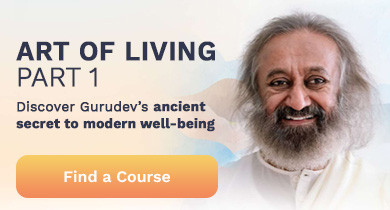By Sejal Shah
Understand pranayama from a scientific and spiritual perspective, so you can experience the mystical power of breath! Plus a link to a free session.
When you go to your meditation or yoga class, you may have heard your teacher giving instructions for breathing in terms of inhaling and exhaling for certain counts. You may have thought, “Hmmm, what is the big deal about counting breaths? I am breathing all the time.”
But there is both mystery and science behind breathing in specific ways.
Let’s explore!
Topics covered:
- Fun facts about breathing
- Pranayama definition, a spiritual perspective
- What are the benefits of pranayama breathing exercises according to science
- Join a FREE breath and meditation session and learn more about the power of breath
Fun facts about breathing
- The breath rarely captures our attention, but it continues to flow in and out on an average of 12-16 times per minute—that's about 20,000 breaths per day!
- If you laid out the lungs flat, they would cover the size of a tennis court (about 753 sq ft). The average person breathes in the equivalent of 1.625 gallons of air every minute. That is about 2340 gallons per day. But most of us use only two thirds of our optimal lung capacity. Learning to breathe properly can help us to use our full lung capacity.
- Most people can hold their breath for a maximum of 1-2 minutes, but in 2010 Stig Severinsen from Denmark held his breath during a free dive for 22 minutes. That’s the power of controlled breathing (Warning: Never try to do this without learning from an expert).
- 70% of toxins are eliminated through your lungs simply by breathing.
- Your emotions change the way you breathe. Research has shown that your breathing patterns can influence the emotions you experience. Learning to breathe in specific ways can help you manage your emotions and your mind.
- Breathing is the only autonomous system of the body that we can also control. This means that the body governs it, but we can change how we breathe through conscious breathing practices such as pranayama as taught by ancient yogis.
Pranayama definition, a spiritual perspective
Pranayama is an ancient practice of yogic breathing techniques used to harness and regulate universal life force energy known as prana. It is an important practice under the umbrella of yoga, often integrated into asana (physical postures) practice as well as a preparatory step for meditation.
Pranayama is composed of two Sanskrit words; “Prana” meaning “universal life force energy,” and “Yama” meaning “regulation”. The breath harnesses prana, and pranayama can be understood as methods to extend and expand vital life force energy through deliberate breath control.
These techniques involve breathing through the nostrils in specific patterns of inhalation, breath retention, and exhalation.
Some common pranayama techniques include victory breath, bellows breath, bee breath, and alternate nostril breathing.
Pranayama exercises help to clear physical and emotional blocks or obstacles in the body so that the breath and prana can flow freely.
From a spiritual perspective, when we practice pranayama, the veil of ignorance that covers the inner light is removed.
The stages of pranayama
The four discernable stages of pranayama are:
- Inhalation
- The mindful pause after inhalation
- Exhalation
- The mindful pause after exhalation
The mindful pause exists in between the active processes of inhalation and exhalation. Also called breath retention, the mindful pause can be more of an advanced technique, so one should seek proper guidance before practicing.
Breath retention increases mental and physical endurance, and places an emphasis on stillness. The aim is not to see how long you can hold your breath! The breath needs to be smooth and even, and never strained during breath retention.
What are the benefits of pranayama breathing exercises according to science?
The practice of pranayama breathing offers multifold benefits. As mentioned in one article in Healthline, these have been extensively researched and documented. Here are some other research statistics:
1. Lowers stress
As per a 2013 study, pranayama reduced perceived stress levels in healthy young adults. The research revealed that pranayama calms the nervous system, which improves your stress response.
Another 2013 study found that individuals who practiced pranayama experienced less anxiety before taking a test. The authors of the study linked this effect to the increased oxygen uptake during pranayama. Oxygen is energy for all your vital organs, including your brain.
2. Improves sleep quality
In clinical studies, a breathing technique known as Bhramari Pranayama (humming bee breath) was shown to slow down breathing and heart rate when practiced for 5 minutes. This can help calm your body for sleep.
According to 2019 research, the practice of pranayama also helps to improve sleep quality in people with sleep apnea. Additionally, the study found that practicing pranayama decreased snoring and daytime sleepiness, suggesting benefits for better quality rest.
3. Enhances cognitive performance
Yet another 2013 study found that 12 weeks of slow or fast pranayama improved executive function — which includes your working memory, cognitive flexibility, reasoning skills, auditory memory, and sensory-motor performance.
According to the researchers, these benefits are due to the stress-lowering effects of pranayama. The increased oxygen uptake, which energizes brain cells, likely plays a role as well.
4. Increases mindfulness
For the majority of us, breathing is automatic. We do it without giving it much thought at all. But during pranayama, you need to be aware of your breathing and how it feels. With light attention on the breath, the mind naturally comes to the present moment, instead of the past or future.
In a 2017 study, students who practiced pranayama displayed higher levels of mindfulness than those who didn’t. The same students also showed better levels of emotional regulation. This was associated with the calming effect of pranayama, which supports your ability to be more mindful.
The researchers also mentioned that pranayama helps remove carbon dioxide and raises oxygen concentration which fuels brain cells. This may contribute to mindfulness by improving focus and concentration.
5. Improves lung function
As a type of breathing exercise, the slow, forceful breathing of pranayama may strengthen your lungs.
One 2019 study determined that 6 weeks of practicing pranayama for 1 hour a day could have a significant effect on lung function. The practice improved multiple parameters of lung function, according to pulmonary test results.
According to the authors of the study, pranayama may be a useful lung strengthening tool for many lung conditions, including asthma and allergic bronchitis, and may also be helpful for recovery from pneumonia and tuberculosis.
6. Reduces high blood pressure
High blood pressure, or hypertension, is when your blood pressure reaches an unhealthy level. It increases the risk for some potentially serious health conditions like heart disease and stroke.
Stress is a major risk factor for high blood pressure. Pranayama can help minimize this risk by promoting relaxation.
In a 2014 study, participants with mild hypertension received anti-hypertensive drugs for 6 weeks. Half of the participants also received pranayama training for 6 weeks. By the end of the study, the latter group experienced a greater reduction in blood pressure.
When you focus on your breathing, it can help calm your nervous system. This, in turn, may help reduce your stress response and risk of hypertension.
7. Reduces cigarette cravings
There’s evidence that yogic breathing, or pranayama, could decrease cravings in people who are trying to quit smoking.
In a 2012 study, just 10 minutes of yogic breathing caused a short-term reduction in cigarette cravings.
A recent study found that mindfulness-based yoga breathing decreased the negative effects associated with smoking withdrawal.
Beyond pranayama
SKY Breath Meditation, a breath-based practice which is more powerful than pranayama, has been shown by more than 100 independent studies to have tremendous benefits for the mind and body. This is where science meets mystery!
SKY Breath Meditation benefits include:
- 33% increase in immune cell count
- Greater mental focus
- 56% decrease in stress hormones
- Reduced symptoms of post traumatic stress
- 21% increase in life satisfaction
- Enhanced deep sleep
- Significant decrease in anxiety
Join a FREE breath and meditation session and learn more about the power of breath
If you haven’t practiced pranayama before, it is recommended you join a yoga class or take an Art of Living program like SKY Breath Meditation, and learn the proper technique for doing breathing exercises. The SKY program includes Ujjayi breathing exercises and bellows breath.
We offer a free online session with a live instructor to guide you through an easy pranayama exercise and meditation. You will also learn more about our pillar program, SKY Breath Meditation. Click the image below to schedule your free session now!
No breath, no life! Know your breath, know your life! Start a regular pranayama practice and start enjoying your life more and more!
Sejal Shah, E-RYT 500 Sri Sri Yoga Teacher, YACEP, C-IAYT, Meditation Teacher, SKY Instructor, NYU Post Graduate Medical School approved Yoga-CME retreat facilitator, Mind-Body Wellness Writer, Homeopath. She can be followed on YouTube, Instagram, Twitter, and Facebook.



























